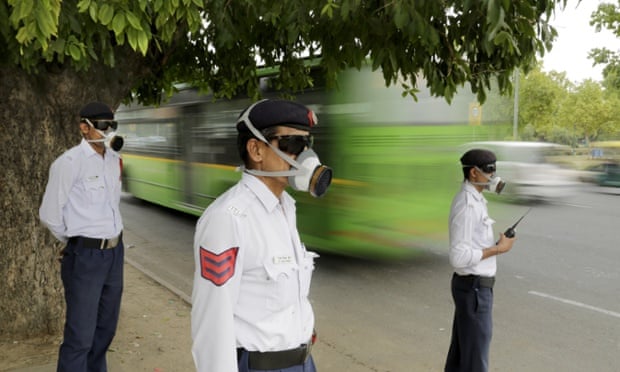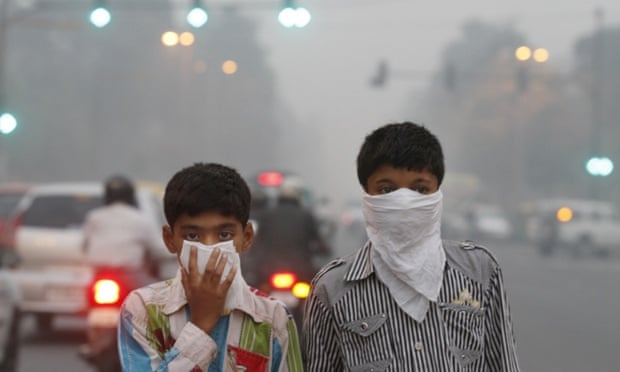Child health fears at the most polluted spot in the world's most polluted city
The dusty patch of ground in the centre of the narrow lanes and overcrowded tenements of Anand Vihar Colony is empty. No children play cricket, wrestle or run. Even when evening comes and the searing Indian summer temperatures subside, they will remain with their marbles or toys indoors in this poor Delhi neighbourhood.
Basona Bhadra, 26, watches her eight-year-old son, Varu, pour water from one cup to another on her kitchen floor. “He gets breathless and ill,” she says. “He doesn’t like going out any more. He is happier at home.”
Bhadra and her family moved from the city of Meerut, 50 miles away, to Anand Vihar, in the east of the Indian capital, four months ago. She blames the heat for the hacking cough that made her child abandon the energetic games he used to enjoy.
Local doctors disagree. Abhinav Agarwal, a paediatrician in nearby Vaishali, says around a third of his patients suffer chronic respiratory ailments – a consequence, he says, of Delhi’s appalling pollution.
Agarwal’s conclusions are backed by data. A survey released last year by theWorld Health Organisation found that Delhi was the most polluted city in the world, with an annual average of 153 micrograms of the most dangerous small particulates, known as PM2.5s, per cubic metre.
The level was six times the WHO’s recommended maximum, 12 times US standards and more than twice the level considered safe even by Indian authorities. During winter, when lower temperatures and fires intensify the pollution, concentrations of PM2.5s routinely spike much higher, regularly reaching levels described by experts as hazardous for humans.
The worst hit among Agarwal’s patients are children, particularly those aged between two and seven. “They are the most vulnerable. It’s been bad for years now. I don’t know if it’s getting worse, or not. It’s definitely not getting better,” he says.
There are now fears that millions of children in India will suffer serious health problems later in life.
“If you look at lung function in children [here], there is significant decline with constant exposure. This will probably be irreversible. For adults, there is also a more rapid decline than usual with age. Some suggest it is the equivalent of smoking around 10 cigarettes per day. There is also a higher chance of developing coronary and arterial disease,” says Dr Guleria, a lung specialist at the All India Institute of Medical Sciences.
The WHO found that India has the world’s highest rate of death from respiratory disease, with 159 per 100,000 in 2012, about 10 times that of Italy, five times that of the UK and twice that of China. One studyfound that half of Delhi’s 4.4 million schoolchildren would never recover full lung capacity.
Much depends on levels of exposure, which means that children, who in India often cycle or walk to school along busy roads, receive extremely high doses of toxic chemicals and damaging particulates. Daily levels in schools are four times worse than those that are supposed to trigger alerts in London.
In Anand Vihar, the factors that cause pollution across Delhi are particularly severe. There is heavy traffic, swollen by often badly maintained and old trucks and buses; huge landfill rubbish dumps which are sometimes set on fire; filthy industries just a few miles from the city; two coal-fired power stations; nearby intensive construction which generates choking clouds of dust; and, seasonally, smoke from crop burning in fields from farmland in neighbouring states.
Another blackspot in Delhi is Munirka, in the south of the city and close to two heavily congested ring roads.
Meenu Singh, a Munirka resident whose eight-year-old son has severe asthma which doctors blame on pollution, says she would leave the city if she could.
I’m really worried about my child’s health. I don’t want him to be in Delhi, but we have no choice at the moment. He is missing exams and school so his education is suffering. We would hope to one day send him to boarding school and even abroad so that he can live an healthy life,” she says.
Many expatriate workers have already left the city, with some major international companies now preferring to base executives in Dubai or Bangkok. Classes at international schools in the city have been cut as numbers dwindle.
Delhi saw significant improvement in its air quality a decade ago following a slew of measures including converting buses and autorickshaws to run on gas, moving small industries to zones on the outskirts of the city and raising emission standards. But benefits were swiftly lost.
We could not keep the momentum. Now there is a new challenge, and it is much more complicated,” says Anumita Choudhury of the Centre for Science and Environment (CSE), a Delhi thinktank.
Choudhury says the problem is a “mobility crisis” in Delhi as use of private vehicles has soared while public transport has suffered chronic under-investment. Between 1991 and 2011, the population of Delhi and its adjoining cities more than doubled to 22 million while the number of registered cars and motorbikes increased fivefold to around 8m.
“We love our cars these days and middle class families have two, three, four of them,” says Surender Sharma, a retired senior air force officer in Delhi who moved to the top floor of a high rise block on the city’s outskirts three years ago to escape air pollution.
Environmentalists say between 40% and 50% of the dangerous PM2.5 particulates in Delhi are caused by vehicles. The figures have been challenged by the car industry. One major problem, all admit, is the 70,000 trucks which drive through the city every night on long-distance journeys. A plan to build a bypass has been repeatedly delayed.
A new metro has barely made an impact, experts say, as almost all those who use it were previously using buses or bicycles, not cars.
After being ignored by the media and politicians for many years, the problem of toxic air is now becoming a significant domestic issue with newspapers highlighting the problem.
“Clean air is a human right,” Prakash Javadekar, the environment minister, said earlier this year.
The Bharatiya Janata party government won a landslide victory at an election last year. The prime minister, Narendra Modi, campaigned on a promise of boosting India’s flagging growth. It has been unclear how he intends to reconcile economic development with protection of India’s forests and rivers and an improvement in air quality.
Conflicts between local and national governments, and between agencies, have also hampered efforts.
The result is that no significant policies beyond a national air monitoring index have yet been announced, while many measures introduced elsewhere, such asclosing schools during spikes of pollution or forcing old vehicles off the road, have been rejected.
“Only 14% of individual journeys in Delhi are made in private vehicles. It is a small minority who are determining policy in this city so the majority voice has to come out louder to determine travel and investment choices,” says Choudhury, of the CSE.
The problem is not restricted to the capital. According to the WHO, 13 of the dirtiest 20 cities in the world are in India.
Child health fears at the most polluted spot in the world's most polluted city
![Child health fears at the most polluted spot in the world's most polluted city]() Reviewed by Thailand Life
on
1:53 AM
Rating:
Reviewed by Thailand Life
on
1:53 AM
Rating:




No comments: